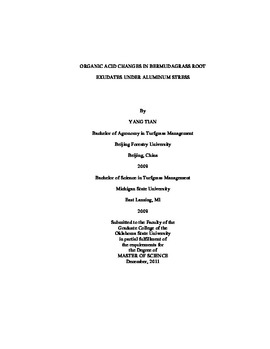| dc.contributor.author | Tian, Yang | |
| dc.date.accessioned | 2014-04-15T22:32:29Z | |
| dc.date.available | 2014-04-15T22:32:29Z | |
| dc.date.issued | 2011-12-01 | |
| dc.identifier.uri | https://hdl.handle.net/11244/9595 | |
| dc.description.abstract | Root exudates can act as root zone chelators to reduce harmful effects when plants are under heavy metal stress. Aluminum toxicity in acidic soils is a common problem in bermudagrass areas across the United States. Therefore, a controlled environment study was developed to evaluate organic acid changes of `Princess-77'. Aluminum (AlK(SO4)2 12H2O) treatments were applied at 100 ppm and 200 ppm to bermudagrass growing in a 4.5 pH sand profile. Treatments also included a 4.5 pH treatment with no Al and a 7.0 pH control with no Al. Each treatment was replicated three times in a randomized complete block design. Five organic acids (oxalate, citrate, malate, malonate, and succinate) were found in bermudagrass root tissues. Citric and malic acid were the dominant acids compared to oxalic acid. Oxalic acid only accounted for 11 % of the total organic acid concentration in root tissues compared that in root exudate samples (63 %), which may indicate the specific response of oxalic acid to external Al stress. Al was accumulated in shoot tissues at concentrations of 1214.41 mg/kg and 2261.13 mg/kg dry wt. under 100 ppm and 200 ppm Al treatment respectively. There was a significant (P = 0.01) negative linear relationship (r2 = 0.61) between Al leaf accumulation and bermudagrass root mass where root mass decreased significantly (P < 0.05) as Al accumulation increased. Citric, malic, oxalic, and succinic acid were found in bermudagrass root exudates. Oxalic acid was the dominant acid accounting for 51-81 % of total organic acids and the exudation rate had a significant (P = 0.01) positive linear relationship (r2 = 0.78) with external Al concentrations. Citric acid was induced by Al stress and higher exudation rate was detected in 100 ppm Al stress, the average exudation rate of malic acid also increased under Al treatment compared to the control treatments. The results indicated potential Al tolerance mechanisms presented in bermudagrass cultivar `Princess-77'. | |
| dc.format | application/pdf | |
| dc.language | en_US | |
| dc.publisher | Oklahoma State University | |
| dc.rights | Copyright is held by the author who has granted the Oklahoma State University Library the non-exclusive right to share this material in its institutional repository. Contact Digital Library Services at lib-dls@okstate.edu or 405-744-9161 for the permission policy on the use, reproduction or distribution of this material. | |
| dc.title | Organic acid changes in bermudagrass root exudates under aluminum stress | |
| dc.type | text | |
| osu.filename | Tian_okstate_0664M_11768.pdf | |
| osu.college | Agricultural Sciences and Natural Resources | |
| osu.accesstype | Open Access | |
| dc.description.department | Horticulture and Landscape Architecture Department | |
| dc.type.genre | Thesis | |
| dc.subject.keywords | aluminum stress | |
| dc.subject.keywords | bermudagrass | |
| dc.subject.keywords | organic acid | |
| dc.subject.keywords | root exudate | |
